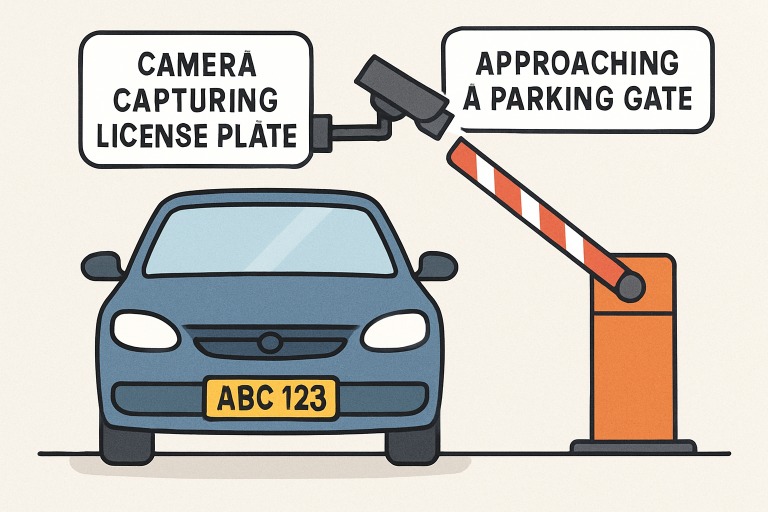What Are License Plate Recognition Systems?
License plate recognition (LPR) systems use advanced imaging technology and optical character recognition to automatically capture and interpret vehicle license plates as drivers enter or exit a parking facility. These systems play a significant role in modern parking environments by streamlining access, improving efficiency, and collecting valuable data for operators.
The origins of LPR technology date back to the 1970s, with early systems constrained by high costs and limited image processing capabilities. In recent years, breakthroughs in machine vision, cloud computing, and AI have made an integrated license plate recognition system for parking more affordable, reliable, and effective than ever. Today, LPR is an attainable solution for parking operators seeking to modernize and enhance their facilities.
How License Plate Recognition Improves Parking Efficiency
By automating vehicle entry and exit, LPR technology virtually eliminates delays associated with manual ticketing and cashier lines. Drivers can now access facilities with minimal interaction as license plates are recognized and exit procedures are similarly streamlined. In busy urban settings, this automation significantly reduces bottlenecks, especially during peak hours. Recent reports, such as this coverage on Goldendale, highlight how communities are increasingly adopting license plate reader cameras to improve parking efficiency and traffic flow.
Payment and validation processes are also expedited. Instead of fumbling for paper tickets or payments, drivers can pay using linked mobile apps or accounts, further minimizing congestion. Major city garages, such as those in New York and Los Angeles, have documented dramatic reductions in wait times and increased throughput by deploying LPR systems. These improvements result in a smoother experience for both customers and operators.
Boosting Security for Vehicles and Operators
Security is a top concern for both parking patrons and facility managers. LPR systems improve safety by creating auditable records of every vehicle that enters or leaves the premises. This detailed log provides crucial information in the event of theft, vandalism, or other security incidents.
Many modern LPR systems are integrated with high-definition security cameras and facility monitoring software to offer 24/7 surveillance. In cases of unauthorized access or suspicious activity, alerts can be generated in real-time, allowing for swift action by security personnel. When incidents do occur, the system’s ability to quickly identify vehicle data accelerates investigations and facilitates rapid recovery of stolen property.
Enhancing Customer Experience in Modern Parking Facilities
Convenience is at the heart of the customer experience in today’s parking facilities. LPR-enabled contactless entry and exit not only reduce physical touchpoints—critical in public health-conscious times—but also create a hassle-free parking routine for regular users. Drivers appreciate the ability to enter and exit without long waits or searching for lost tickets.
Many advanced LPR systems also integrate with mobile applications, providing drivers with personalized notifications, digital receipts, and even reservation options. This level of customization and connectivity sets a new standard for customer satisfaction, encouraging repeat usage in competitive urban parking markets.
Cost Savings and Revenue Generation Through Automation
Automating parking operations results in substantial cost reductions for facility operators. The need for staff to handle check-in, checkout, and payment processes is significantly reduced, allowing staff to focus on higher-value tasks, such as customer assistance and facility maintenance.
Additionally, LPR-generated data enables smarter business decisions. Operators can apply dynamic pricing based on real-time demand, ensuring optimal space utilization and maximizing revenue.
Data Collection and Analytics for Smarter Operations
The wealth of data gathered from LPR systems enables operators to monitor patterns such as space utilization, peak arrival times, and average length of stay. This information is invaluable for operational planning, staff scheduling, and optimizing facility layouts. Cities like San Francisco and Toronto have utilized LPR-derived analytics to guide future parking construction and integrate parking management with broader transportation planning.
Municipalities and private operators alike rely on these insights to make data-driven decisions regarding capacity, pricing strategies, and customer service investments, further enhancing the utility and profitability of parking facilities.
Ethical and Privacy Considerations
With the benefits of data-driven parking come critical ethical considerations, especially privacy. Operators should develop clear guidelines for the storage, access, and use of LPR-generated data, securely encrypting records and restricting access to authorized personnel only.
Transparent communication is key to earning public trust. Drivers want to know how their data is collected, used, and protected. Government technology experts have raised concerns about data privacy and recommend ongoing assessments to strike a balance between operational needs and individual rights.
Steps for Successful Implementation
- Needs Assessment and Selecting the Right LPR Solution: Facility managers must evaluate operational needs, technical requirements, and budgetary constraints before selecting the best LPR system for their specific environment.
- Staff training and public awareness campaigns: Effective rollout depends on well-trained staff and clear communication with customers about new procedures and privacy assurances.
- Ongoing maintenance and technology upgrades: Continuous investment in software updates and hardware maintenance ensures system reliability and future-proofs the parking facility.
Looking Ahead: The Future of LPR in Parking
As cities embrace smart infrastructure, LPR systems are becoming a cornerstone of integrated transportation solutions. By connecting with other smart city networks, parking operators can expand the reach and intelligence of their parking management systems. Artificial intelligence promises further advancements—predictive analytics, proactive maintenance, and even real-time dynamic wayfinding.
Adoption of LPR technology is on the rise worldwide, with urban centers from Singapore to Amsterdam setting new benchmarks for digital, efficient, and customer-centric parking services.
